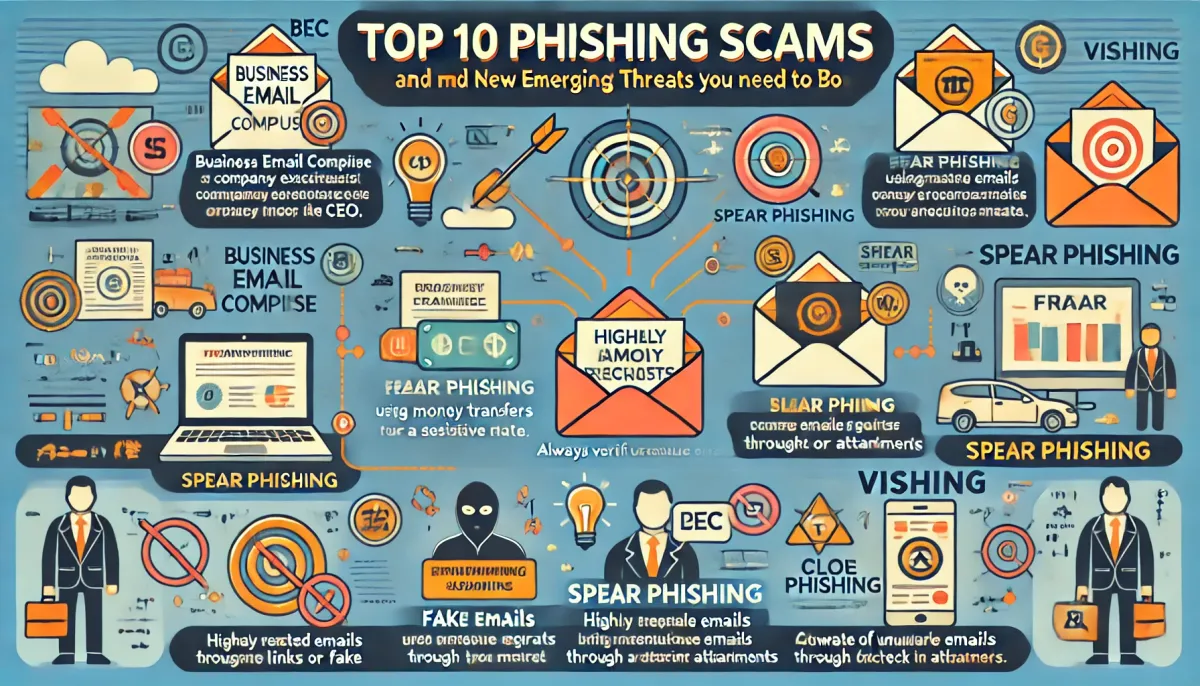Top 10 Phishing Scams to Avoid in 2024

Introduction
Phishing scams are deceptive attempts to obtain sensitive information by acting as trustworthy entities in electronic communications. These scams pose considerable risks to individuals and organizations, leading to data breaches, financial losses, and identity theft. As we progress into 2024, the sophistication of phishing attacks continues to evolve, making it imperative to stay informed and vigilant. This article delves into the top 10 phishing scams to avoid in 2024, providing insights on recognizing, preventing, and protecting against these malicious tactics.
Business Email Compromise (BEC)
Description: Scammers pretend to be company executives or trusted partners when requesting urgent money transfers or sensitive information.
How to Avoid:
· Always verify unusual requests by contacting the person directly through a different method, like a phone call.
· Have strict rules for verifying such requests.
Spear Phishing
Description: Attackers send targeted emails to specific people, using personal information to make the email look real.
How to Avoid:
· Be cautious of emails from unknown sources, even if they seem familiar.
· Always double-check the sender's details and content for any oddities.
Clone Phishing
Description: Scammers create an exact copy of a legitimate email, including malicious links or attachments.
How to Avoid:
· Compare suspicious emails with previous genuine ones.
· Check the URLs and sender details for any discrepancies.
Vishing (Voice Phishing)
Description: Scammers use phone calls to trick people into giving out personal information or transferring money.
How to Avoid:
· Always verify the caller's identity.
· Avoid sharing sensitive information over the phone.
SMiShing (SMS Phishing)
Description: Fraudulent text messages contain links to malicious websites or ask for personal information.
How to Avoid:
· Do not click on links in unsolicited text messages.
· Verify any requests through official channels.
Fake Invoice Scams
Description: Attackers send fake invoices or payment requests that look like they come from trusted suppliers or service providers.
How to Avoid:
· Have procedures to verify financial transactions.
· Cross-check invoices with previous records.
Tech Support Scams
Description: Scammers pose as tech support representatives to gain access to your computer or steal information.
How to Avoid:
· Never allow remote access to your computer from unsolicited tech support calls.
· Verify the legitimacy of the support provider before sharing any information.
Charity Scams
Description: Fraudulent requests for donations to fake charities, often after disasters or significant events.
How to Avoid:
· Research charities before donating.
· Use official websites or trusted platforms for contributions.
Job Offer Scams
Description: Fake job offers that require upfront payments for training, equipment, or background checks.
How to Avoid:
· Be sceptical of job offers that require payments.
· Verify the legitimacy of the employer through independent research.
Social Media Scams
Description: Phishing attacks through social media platforms, often involving fake profiles or messages.
How to Avoid:
· Be cautious of unsolicited messages.
· Verify profiles before interacting and avoid clicking on suspicious links.
New and Emerging Threats in 2024 AI-Generated Phishing Emails
Description: Scammers use AI to create convincing phishing emails that mimic the writing style of trusted contacts.
How to Avoid:
· Be extra careful with email content, even from known sources.
· Use advanced email filtering systems to detect AI-generated emails.
Deepfake Voice Scams
Description: Scammers use deepfake technology to create realistic audio of trusted individuals, often to authorize financial transactions.
How to Avoid:
· Establish verification protocols that require multiple forms of confirmation for sensitive requests.
Deepfake Video Phishing
Description: Attackers create deepfake videos of executives or trusted figures instructing employees to take specific actions.
How to Avoid:
· Verify any video instructions through independent channels.
· Educate employees about the potential misuse of deepfake technology.
Critical Incidents from January to June 2024 AI-Driven Phishing Campaigns
Incident: Several large companies reported sophisticated phishing attacks powered by AI, leading to significant data breaches.
Response: Enhanced security measures with AI technology and ongoing employee training.
Deepfake Ransomware Attacks
Incident: Scammers used deepfake audio and video to impersonate CEOs and demand ransomware payments, successfully tricking several organizations.
Response: Implement multi-factor verification processes and increase staff awareness of deepfake technologies.
General Tips to Stay Safe
· Educate Yourself and Others: Regularly update your knowledge about phishing tactics and share information with others.
· Use Multi-Factor Authentication (MFA): Increase security by requiring multiple verification forms for account access.
· Regularly Update Software: Keep all software, including antivirus programs, up-to-date.
· Monitor Accounts: Regularly check financial records for unauthorized activity.
· Report Phishing Attempts: Inform your IT department or the appropriate authorities about suspected phishing attempts.
By staying informed and vigilant, you can protect yourself and your organization from the evolving landscape of phishing scams in 2024, especially with the rise of AI and deepfake technologies.
Conclusion
Phishing scams continue to pose significant threats in 2024, evolving in sophistication and targeting methods. Staying informed and adopting robust security practices is essential to protect against these malicious activities. By recognizing the signs of phishing and implementing preventive measures, individuals and organizations can safeguard their sensitive information and maintain their digital security.
